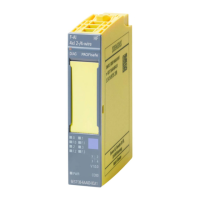General Technical Specifications
6.5 Mechanical and Climatic Environmental Conditions
ET 200S Distributed I/O System - Fail-Safe Modules
58 Installation and Operating Manual, 08/2008, A5E00103686-07
Mechanical Environmental Conditions
The table below shows the mechanical environmental conditions for F-modules in the form of
sinusoidal oscillations.
Frequency Range (Hz) Continuous Intermittent
10 ≤ f ≤ 58 Amplitude = 0.15 mm Amplitude = 0.35 mm
58 ≤ f ≤ 150 Constant acceleration = 2 g Constant acceleration = 5 g
Reduction of Vibration
If the F-modules are exposed to substantial shock or vibration, you must take appropriate
measures to reduce the acceleration and amplitude.
We recommend that you mount the ET 200S on damping material (for example, on a rubber-
metal vibration damper).
Testing of Mechanical Environmental Conditions
The table below provides information about the type and scope of testing of mechanical
environmental conditions.
Condition ... Test Standard Comments
Vibration Vibration test in accordance
with IEC 60068-2-6
(sinusoidal)
Type of vibration: Frequency cycles at a rate of change of 1 octave/minute.
10 Hz ≤ f ≤ 58 Hz, constant amplitude 0.35 mm
58 Hz ≤ f ≤ 150 Hz, constant acceleration 5 g
Duration of vibration: 10 frequency cycles per axis at each one of the three
perpendicular axes
Shock Shock, tested in accordance
with IEC 60068-2-27
Shock type: Half-sine
Shock severity: 15 g peak value, 11 ms duration
Direction of shock: 3 shocks in +/- direction at each of the three
perpendicular axes
Continuous
shock
Shock, tested in accordance
with IEC 60068-29
Shock type: Half-sine
Shock severity: 25 g peak value, 6 ms duration
Direction of shock: 1000 shocks in +/- direction at each of the three
perpendicular axes

